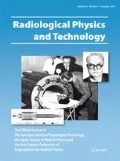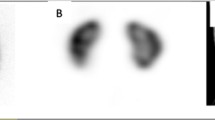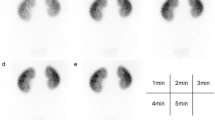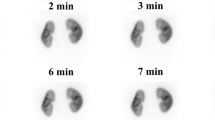Abstract
The present study aimed to evaluate whether the use of a smoothing filter would improve the image quality in pediatric 99mTc-dimercaptosuccinic acid (99mTc-DMSA) scintigraphy. We retrospectively reviewed 31 kidneys in 16 consecutive pediatric patients aged 10 months to 14 years. The administered dose was calculated using a weight-based method. Two reviewers randomly evaluated the original planar posterior images and smoothing filter image; they assessed image quality and performed defect evaluations. The evaluation of visual image quality yielded significantly better results for the smoothing filter images than for the original images. Although the smoothing filter images were slightly inferior to the original images in terms of edge sharpness, no significant difference was observed in the defect evaluation. We confirmed that 99mTc-DMSA scintigraphy with a smoothing filter yielded reduced image noise, while maintaining defect evaluation performance and improving image quality.



Similar content being viewed by others
References
Goldraich NP, Goldraich IH. Update on dimercaptosuccinic acid renal scanning in children with urinary tract infection. Pediatr Nephrol. 1995;9:221–6.
Snodgrass WT, Shah A, Yang M, Kwon J, Villanueva C, Traylor J, et al. Prevalence and risk factors for renal scars in children with febrile UTI and/or VUR: a cross-sectional observational study of 565 consecutive patients. J Pediatr Urol. 2013;9:856–63.
Goswami R, Bal CS, Tejaswi S, Punjabi GV, Kapil A, Kochupillai N. Prevalence of urinary tract infection and renal scars in patients with diabetes mellitus. Diabetes Res Clin Pract. 2001;53:181–6.
Kari JA, El-Desoky SM, Basnawi F, Bahrawi O. Vesicouretheric reflux in children. Urology Annals. 2013. pp. 232–6.
Chroustová D, Palyzová D, Urbanová I, Kolská M. Results of a five-year study of 99mTc DMSA renal scintigraphy in children and adolescents following acute pyelonephritis. Nucl Med Rev Cent East Eur. 2006;9(1):46–50.
Fahey FH, Treves ST, Adelstein SJ. Minimizing and communicating radiation risk in pediatric nuclear medicine. J Nucl Med. 2011;52:1240–51.
Yuille DL. A new approach to the smoothing of dynamic nuclear medicine data. Concise communication. J Nucl Med. 1978;19:836–44.
King MA, Doherty PW, Schwinger RB, Jacobs DA, Kidder RE, Miller TR. Fast count-dependent digital filtering of nuclear medicine images. Concise communication. J Nucl Med. 1983;24:1039–45.
Miller TR, Rollins ES. A practical method of image enhancement by interactive digital filtering. J Nucl Med. 1985;26:1075–80.
Hofheinz F, Langner J, Beuthien-Baumann B, Oehme L, Steinbach J, Kotzerke J, et al. Suitability of bilateral filtering for edge-preserving noise reduction in PET. EJNMMI Res. 2011;1:23.
Yousif MYA, Eltayeb W. Enhancement of nuclear medicine images using filtering technique. Int J Sci Res. 2014;3(8):916–21.
Davies ER. Computer and machine vision: theory, algorithms, practicalities fourth edition. Academic Press 2012; chap 3, 38–80.
Protonotarios NE, Fokas AS, Kostarelos K, Kastis GA. The attenuated spline reconstruction technique for single photon emission computed tomography. J. R. Soc. Interface 2018 Nov; 28, 15(148).
Zaidi H. Quantitative analysis in nuclear medicine imaging. Berlin, Germany: Springer; 2006.
Yanai H. Statcel-The useful add-in software forms on excel. 3rd ed. Tokyo: OMS; 2011.
Eggli DF, Tulchinsky M. Scintigraphic evaluation of pediatric urinary tract infection. Semin Nucl Med. 1993;23(3):199–218.
Yen TC, Chen WP, Chang SL, Liu RS, Yeh SH, Lin CY. Technetium-99m-DMSA renal SPECT in diagnosing and monitoring pediatric acute pyelonephritis. J Nucl Med. 1996;37:1349–53.
Piepsz A. Cortical scintigraphy and urinary tract infection in children. Nephrol Dial Transplant. 2002;17:560–2.
Piepsz A, Colarinha P, Gordon I, Hahn K, Olivier P, Roca I, et al. Guidelines on Tc-99m DMSA scintigraphy in children (2009). Eur J Nucl Med 2001 Mar; 28(3): BP37–41.
Mandell GA, Eggli DF, Gilday DL, Heyman S, Leonard JC, Miller JH, et al. Procedure guideline for renal cortical scintigraphy in children. J Nucl Med. 1997;38:1644–6.
Ziessman HA, Majd M. Importance of methodology on 99mTechnetium dimercaptosuccinic acid scintigraphic image quality: Imaging pilot study for RIVUR (Randomized intervention for children with vesicoureteral reflux) multicenter investigation. J Urol. 2009;182:272–9.
Klare B, Geiselhardt H, Scharer WK, Immich H, Willich E. Radiological kidney size in childhood. Pediatr Radiol. 1980;9:153–60.
Han BK, Badcock DS. Sonographic measurements and appearance of normal kidneys in children. AJR. 1985;145:611–6.
Kadioglu A. Renal measurements, including length, parenchymal thickness, and medullary pyramid thickness, in healthy children: What are the normative ultrasound values? AJR. 2010;194:509–15.
Kiyoshi K, Masaki H, Hiroshi M, Mayuki U, Mitsuo O, Eiji O, et al. Japanese consensus guidelines for pediatric nuclear medicine. Ann Nucl Med. 2014;28:498–503.
Arlachov Y1, Ganatra RH. Sedation/anaesthesia in paediatric radiology. Br J Radiol 2012; 85(1019): e1018–1031.
Steven W S. The scientist and engineer’s guide to digital signal processing, second edition. California Technical publishing 2003; chap 15, 277–284.
Tarkington MA, Fildes RD, Levin K, Ziessman H, Harkness B, Gibbons MD. High resolution single photon emission computerized tomography (SPECT) 99mtechnetium-dimercapto-succinic acid renal imaging: a state of the art technique. J Urol. 1990;144:598–600.
Everaet H, Flamen P, Franken PR, Peeters P, Bossuyt A, Piepsz A. 99Tcm-DMSA renal scintigraphy for acute pyelonephritis in adults: planar and/or SPET imaging? Nucl Med Commun. 1996;17:884–9.
Applegate KE, Connolly LP, Davis RT, Zurakowski D, Treves ST. A prospective comparison of high-resolution planar, pinhole, and triple-detector SPECT for the detection of renal cortical defects. Clin Nucl Med. 1997;22:673–8.
Brenner M, Bonta D, Eslamy H, Ziessman HA. Comparison of 99mTc-DMSA dual-head SPECT versus high-resolution parallel-hole planar imaging for the detection of renal cortical defects. AJR Am J Roentgenol. 2009;193:333–7.
Farghaly HRS, Sayed MHM. Technetium-99m dimercaptosuccinic acid scan in evaluation of renal cortical scarring: Is it mandatory to do single photon emission computerized tomography? Indian J Nucl Med 2015 Jan-Mar; 30 (1): 26–30.
Mannes F, Bultynck E, Roijen NV, Mauten LVD, Piepsz A, Ham HR. Utility of posterior oblique views in 99mTc-DMSA renal scintigraphy in children. J Nucl Med Technol. 2003;31:72–3.
Craig JC, Irwig LM, Howman-Giles RB, Uren RF, Bernard EJ, Knigh JF, et al. Variability in the interpretation of dimercaptosuccinic acid scintigraphy after urinary tract infection in children. J Nucl Med. 1998;38:1428–32.
Rossleigh MA, Farnsworth RH, Leighton DM, Yong JLC, Rose M, Christian CL. Technetium-99m Dimercaptosuccinic acid scintigraphy studies of renal cortical scarring and renal length. J Nucl Med. 1998;39:1280–5.
Brenner DJ, Hall EJ. Computed tomography: an increasing source of radiation exposure. N Engl J Med. 2007;357(22):2277–84.
Khalil MM. Basic sciences of nuclear medicine. Berlin: Springer; 2010.
Salihin MN, Zakaria A. Determination of the optimum filter for qualitative and quantitative 99mTc myocardial SPECT imaging. Iran J Radiat Res. 2009;6(4):173–82.
King MA, Glick SJ, Penney BC, Schwinger RB, Doherty PW. Interactive visual optimization of SPECT prereconstruction filtering. J Nucl Med. 1987;28(7):1192–8.
Links JM, Jeremy RW, Dyer SM, Frank TL, Becker LC. Wiener filtering improves quantification of regional myocardial perfusion with thallium-201 SPECT. J Nucl Med. 1990;31(7):1230–6.
Lorimer L, Gemmell HG, Sharp PF, McKiddie FI, Staff RT. Improvement in DMSA imaging using adaptive noise reduction: an ROC analysis. Nucl Med Commun. 2012;33(11):1212–6.
Author information
Authors and Affiliations
Corresponding author
Ethics declarations
Conflict of interest
The authors declare that they have no conflict of interest.
Statement of human and animal rights
This study was approved by the Ethics Committees of Hirosaki University and Akita Kousei Medical Center (Approval No. 2015-024 and No. 45). All procedures performed in studies involving human participants were in accordance with the ethical standards of the Institutional Review Board (IRB) and with the 1964 Helsinki declaration and its later amendments or comparable ethical standards. The IRB was obtained without patients’ informed consent. This article does not contain any studies with animals performed.
Informed consent
Since this study uses past inspection data, it does not conduct any new inspections. Personal information is anonymized, and do not use personal identifying information such as the name and address of the data provider. Therefore, informed consent will not be acquired. This article does not contain any studies with human participants.
Additional information
Publisher's Note
Springer Nature remains neutral with regard to jurisdictional claims in published maps and institutional affiliations.
About this article
Cite this article
Saito, H., Ito, T., Omachi, K. et al. Effectiveness of the smoothing filter in pediatric 99mTc-dimercaptosuccinic acid renal scintigraphy. Radiol Phys Technol 13, 104–110 (2020). https://doi.org/10.1007/s12194-020-00553-8
Received:
Revised:
Accepted:
Published:
Issue Date:
DOI: https://doi.org/10.1007/s12194-020-00553-8




